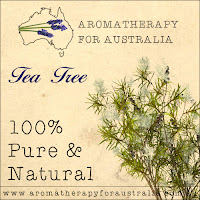TEA TREE ESSENTIAL OIL
Family Name: Myrtaceae
Common Name: Tea Tree
Botanical Name: Melaleuca alternifolia
Extraction method: Steam distillation of the leaves or aerial parts.
Odour: 'Warm, spicy aromatic odour'.
General Description:
Tea tree is a small tree, growing to a height of seven metres with narrow, soft, alternate leaves and yellowish flowers the shape of bottlebrushes. One of more than 30 species of "paperbark" trees that flourish in Australia, tea tree belongs to the Melaleuca genus, and is closely related to Melaleuca leucadendron (the source of cajuput oil) and Melaleuca quinquinervia (which produces niaouli oil).
The name Melaleuca comes from the Greek melas (black) and leukos (white) — referring to the contrast between the dark-green foliage, which appears black, and the loose, paper-thin and very white bark.
History/Folk lore:
The Australian aborigines have long recognized the virtues of Tea Tree. When the rest of the world thought it was just a weed, the Aborigines used the leaf to cure infected wounds. It was introduced into Europe around 1927 and its excellent antiseptic quality was quickly noted. Indeed the English settlers followed the example set by the Aborigines and found the leaves useful when medical supplies were unobtainable.
Active research has been carried out in Australia, America and France on its anti-infectious and anti-fungal power especially in treating a variety of skin conditions. During World War II, it was included in military aid kits in tropical areas as well as in ammunition factories for skin injuries.
It has gained popularity as a household remedy for cuts, burns, insect bites, acne, mouth ulcers, herpes, aches and sprains. It kills bacteria when propelled through air conditioning ducts and its fragrance, as well as its antiseptic properties, have made the oil useful in detergents and various other household products.
Active research has been carried out in Australia, America and France on its anti-infectious and anti-fungal power especially in treating a variety of skin conditions. During World War II, it was included in military aid kits in tropical areas as well as in ammunition factories for skin injuries.
It has gained popularity as a household remedy for cuts, burns, insect bites, acne, mouth ulcers, herpes, aches and sprains. It kills bacteria when propelled through air conditioning ducts and its fragrance, as well as its antiseptic properties, have made the oil useful in detergents and various other household products.
Main Uses In Massage:
Tea tree is one of the essential oils that has had the most laboratory and clinical testing done. It has marked anti-viral activity — it is useful in a take-home blend for clients who are contraindicated for massage because they are starting a viral infection with a fever.
Tea tree is a powerful antiseptic, and it can be put into blends for clients to use at home to treat any bacterial infections. It seems to be able to kill harmful bacteria without greatly disturbing the normal beneficial bacteria in the body.
Tea tree is a powerful antiseptic, and it can be put into blends for clients to use at home to treat any bacterial infections. It seems to be able to kill harmful bacteria without greatly disturbing the normal beneficial bacteria in the body.
Therapeutic Properties or Actions:
Antimicrobial, antifungal, antiseptic, bactericide, cicatrisant, expectorant, fungicide, immunostimulant, insecticide, stimulant, sudorific.
Body Systems & Therapeutic Uses:
Skin Care - Recommended for the treatment of acne, athlete's foot, blisters, burns, cold sores, dandruff, insect bites, oily skin rashes, verrucae, warts and wounds.
Respiratory system - Recommended for the treatment of asthma, bronchitis, catarrh, coughs, sinusitis.
Immune system - Patricia Davis recommends tea tree oil for debilitating illnesses such as glandular fever, and for people who repeatedly succumb to infections or who are slow to recover from any illness.
Genito/urinary system - Recommended for the treatment of thrush, vaginitis, cystitis and pruritus.
Body Systems & Therapeutic Uses:
Skin Care - Recommended for the treatment of acne, athlete's foot, blisters, burns, cold sores, dandruff, insect bites, oily skin rashes, verrucae, warts and wounds.
Respiratory system - Recommended for the treatment of asthma, bronchitis, catarrh, coughs, sinusitis.
Immune system - Patricia Davis recommends tea tree oil for debilitating illnesses such as glandular fever, and for people who repeatedly succumb to infections or who are slow to recover from any illness.
Genito/urinary system - Recommended for the treatment of thrush, vaginitis, cystitis and pruritus.
Precautions:
None at usual doses except:
- May cause irritation on sensitive areas of skin, and
- Some possible allergic reactions.
< Shop for tea tree essential oil >

I will be posting more information about other essential oils on this blog so keep checking back.
< Related articles - ginger , lavender , lemon , peppermint & rosemary >
Information on this page is for educational purposes only and should not replace advice from a medical practitioner.
© Graphics are property of Aromatherapy For Australia. Please do not use images without permission or without credit or link back to this blog post. Please read our Terms & Conditions



No comments:
Post a Comment